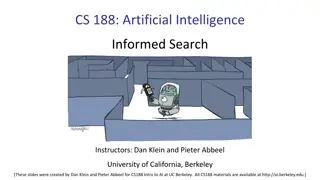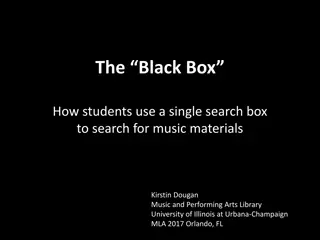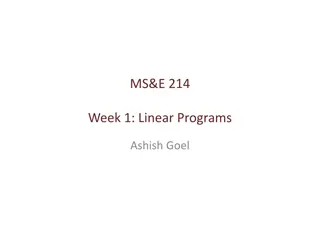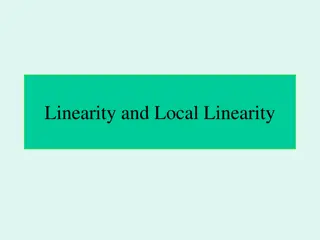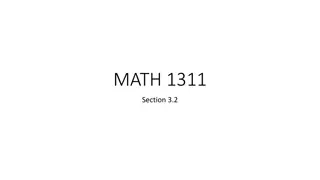Understanding Linear Search: A Detailed Guide
Linear search is a fundamental algorithm for finding a value in an array. This guide covers the concept, code implementation, examples, time complexity analysis, and comparison with binary search. Explore how linear search works, its best and worst-case scenarios, and why search time matters in programming.
Download Presentation

Please find below an Image/Link to download the presentation.
The content on the website is provided AS IS for your information and personal use only. It may not be sold, licensed, or shared on other websites without obtaining consent from the author. Download presentation by click this link. If you encounter any issues during the download, it is possible that the publisher has removed the file from their server.
E N D
Presentation Transcript
Search Lesson Outline 1. 2. 3. 4. 5. 6. 7. 8. 9. 10. 11. 12. 13. 14. 15. Searching Lesson Outline How to Find a Value in an Array? Linear Search Linear Search Code Linear Search Example #1 Linear Search Example #2 Linear Search Example #3 Linear Search Example #4 Linear Search Example #5 Linear Search Example #6 How Long Does Linear Search Take? Linear Search: Best Case Linear Search: Worst Case Linear Search: Average Case Why Do We Care About Search Time? 16. 17. 18. 19. 20. 21. 22. 23. 24. 25. 26. 27. 28. 29. 30. 31. 32. 33. 34. Big-O Notation #1 Big-O Notation #2 Big-O Notation #4 Big-O Notation #5 Big-O Notation #6 Linear Search Code, Again Linear Search is O(n) in the Average Case A Better Search? Faster Search Requires Sorted Data Binary Search Binary Search Code Binary Search Code Binary Search Example #1 Binary Search Example #2 Binary Search Example #3 Time Complexity of Binary Search #1 Time Complexity of Binary Search #2 Time Complexity of Binary Search #3 Need to Sort Array Search Lesson CS1313 Spring 2024 1
How to Find a Value in an Array? -23 97 18 21 5 -86 64 0 -37 Suppose you have a big array full of data, and you want to find a particular value. How will you find that value? Search Lesson CS1313 Spring 2024 2
Linear Search -23 97 18 21 5 -86 64 0 -37 Linear search means looking at each element of the array, in turn, until you find the target value. Search Lesson CS1313 Spring 2024 3
Linear Search Code -23 97 18 21 5 -86 64 0 -37 int linear_search (float* array, int number_of_elements, float target_value) { /* linear_search */ const int first_element = 0; const int nonexistent_element = first_element - 1; int element; /* Idiotproofing belongs here. */ for (element = first_element; element < number_of_elements; element++) { if (array[element] == target_value) { return element; } /* if (array[element] == ...) */ } /* for element */ return nonexistent_element; } /* linear_search */ Search Lesson CS1313 Spring 2024 4
Linear Search Example #1 -23 97 18 21 5 -86 64 0 -37 element Searching for -86. Search Lesson CS1313 Spring 2024 5
Linear Search Example #2 -23 97 18 21 5 -86 64 0 -37 element Searching for -86. Search Lesson CS1313 Spring 2024 6
Linear Search Example #3 -23 97 18 21 5 -86 64 0 -37 element Searching for -86. Search Lesson CS1313 Spring 2024 7
Linear Search Example #4 -23 97 18 21 5 -86 64 0 -37 element Searching for -86. Search Lesson CS1313 Spring 2024 8
Linear Search Example #5 -23 97 18 21 5 -86 64 0 -37 element Searching for -86. Search Lesson CS1313 Spring 2024 9
Linear Search Example #6 -23 97 18 21 5 -86 64 0 -37 element Searching for -86: FOUND! Search Lesson CS1313 Spring 2024 10
How Long Does Linear Search Take? Okay, great, now we know how to search. But how long will our search take? That s really three separate questions: How long will it take in the best case? How long will it take in the worst case? How long will it take in the average case? Search Lesson CS1313 Spring 2024 11
Linear Search: Best Case How long will our search take? In the best case, the target value is in the first element of the array. So the search takes some tiny, and constant, amount of time. Computer scientists denote this O(1) which will be explained later. In real life, we don t care about the best case, because it so rarely actually happens. Search Lesson CS1313 Spring 2024 12
Linear Search: Worst Case How long will our search take? In the worst case, the target value is in the last element of the array. So the search takes an amount of time proportional to the length of the array. Computer scientists denote this O(n) which will be explained later. Search Lesson CS1313 Spring 2024 13
Linear Search: Average Case How long will our search take? In the average case, the target value is somewhere in the array. In fact, since the target value can be anywhere in the array, any element of the array is equally likely. So on average, the target value will be in the middle of the array. So the search takes an amount of time proportional to half the length of the array which is proportional to the length of the array O(n) again! Search Lesson CS1313 Spring 2024 14
Why Do We Care About Search Time? We know that time is money. So finding the fastest way to search (or any task) is good, because then we ll save time, which saves money. Search Lesson CS1313 Spring 2024 15
Big-O Notation #1 Suppose we can describe the amount of time it takes to do a task in terms of the number of pieces of data in the task. For example, suppose that our search algorithm takes 3n + 12 time units to execute, where n is the array length. Well, as n becomes very big a million, a billion, etc then we stop caring about the 12, because the 12 is basically zero compared to the 3n term. Search Lesson CS1313 Spring 2024 16
Big-O Notation #2 Suppose we can describe the amount of time it takes to do a task in terms of the number of pieces of data in the task. For example, suppose that our search algorithm takes 3n + 12 time units to execute, where n is the array length. No matter the size of n, the 3 in 3nisn t all that interesting, because running on a different kind of computer changes the actual time cost of a time unit. Search Lesson CS1313 Spring 2024 17
Big-O Notation #4 Suppose we can describe the amount of time it takes to do a task in terms of the number of pieces of data in the task. For example, suppose that our search algorithm takes 3n + 12 time units to execute, where n is the array length. So, we really only care about the n in 3n + 12. Search Lesson CS1313 Spring 2024 18
Big-O Notation #5 Now, suppose we have an algorithm that, for n pieces of data, takes 0.03n2 + 12n + 937.88 time units. Again, we don t care about the constants. And, as n becomes big a million, a billion, etc we no longer care about the n term (12n), because the n term grows far far slower than the n2 term. Nor do we care about the constant term (937.88), which doesn t grow at all. That is, as n becomes big, the smaller terms are so tiny as to be pretty much zero. Search Lesson CS1313 Spring 2024 19
Big-O Notation #6 In the general case, suppose an algorithm on n pieces of data takes: cknk + ck-1nk-1 + ck-2nk-2 + ... + c1n + c0 for constants c0,c1, etc. Keep in mind the principles that we ve already seen: We don t care about the constants ci. We don t care about the terms smaller than nk. We really only care about nk. So we say that this algorithm has time complexity of order nk. We denote this O(nk). We pronounce it big-O of n to the k. Search Lesson CS1313 Spring 2024 20
Linear Search Code, Again -23 97 18 21 5 -86 64 0 -37 int linear_search (float* array, int number_of_elements, float target_value) { /* linear_search */ const int first_element = 0; const int nonexistent_element = first_element - 1; int element; /* Idiotproofing belongs here. */ for (element = first_element; element < number_of_elements; element++) { if (array[element] == target_value) { return element; } /* if (array[element] == ...) */ } /* for element */ return nonexistent_element; } /* linear_search */ Search Lesson CS1313 Spring 2024 21
Linear Search is O(n) in the Average Case Recapping, linear search is O(n) in the average case (and in the worst case, but with different constants). But what if we expect to do lots of searches through our dataset of length n? What if we expect to do n searches on our n data? Well, the time complexity will be n . O(n), which is to say O(n2). You can imagine that, when n is big a million, a billion, etc this is terribly inefficient. Can we do better? Search Lesson CS1313 Spring 2024 22
A Better Search? Consider how you search for someone in the phone book say, Henry Neeman. You start with the first letter of their last name, N. You guess roughly where N would be in the phonebook. You open to that page. If you re wrong, you move either forward or backward in the book that is, if you actually opened to J, you move forward, but if you opened to T, you move backward. You keep repeating this action until you find Neeman. Search Lesson CS1313 Spring 2024 23
Faster Search Requires Sorted Data Why not use linear search? Linear search means start at the beginning, and look at every piece of data, until you find your target. And you have to do this for each and every such search. This is much much slower than the way you search a phonebook in real life. Why? The reason you can do the phonebook search so quickly is because the names in the phonebook are sorted specifically, they re in alphabetical order by last name, then by first name. Search Lesson CS1313 Spring 2024 24
Binary Search The general term for a smart search through sorted data is a binary search. 1. The initial search region is the whole array. 2. Look at the data value in the middle of the search region. 3. If you ve found your target, stop. 4. If your target is less than the middle data value, the new search region is the lower half of the data. 5. If your target is greater than the middle data value, the new search region is the higher half of the data. 6. Continue from Step 2. Search Lesson CS1313 Spring 2024 25
Binary Search Code int binary_search (float* array, int number_of_elements, float target_value) { /* binary_search */ const int first_element = 0; const int nonexistent_element = first_element - 1; int low_element, middle_element, high_element; /* Idiotproofing goes here. */ /* Start with the entire array as the search region. */ low_element = first_element; high_element = number_of_elements 1; Search Lesson CS1313 Spring 2024 26
Binary Search Code while ((low_element > first_element) && (high_element < number_of_elements) && (low_element < high_element)) { /* Examine the middle of the current search region. */ middle_element = (low_element + high_element) / 2; /* What should we search next? */ if (array[middle_element] < target_value) { /* Reduce the search region to the lower half. */ high_element = middle_element - 1; } /* if (array[middle_element] < target_value) */ else if (array[middle_element] > target_value) { /* Reduce the search region to the higher half. */ low_element = middle_element + 1; } /* if (array[middle_element] > target_value) */ else { /* Target has been found, so stop searching. */ low_element = middle_element; high_element = middle_element; } /* if (array[middle_element] > ...)...else */ } /* while (low_element < high_element) */ if (high_element == low_element) { return middle_element; } /* if (high_element == low_element) */ return nonexistent_element; } /* binary_search */ Search Lesson CS1313 Spring 2024 27
Binary Search Example #1 -86 -37 -23 0 5 18 21 64 97 low middle high Searching for 18. Search Lesson CS1313 Spring 2024 28
Binary Search Example #2 -86 -37 -23 0 5 18 21 64 97 low high middle Searching for 18. Search Lesson CS1313 Spring 2024 29
Binary Search Example #3 -86 -37 -23 0 5 18 21 64 97 low high middle Searching for 18: FOUND! Search Lesson CS1313 Spring 2024 30
Time Complexity of Binary Search #1 How fast is binary search? Think about how it operates: after you examine a value, you cut the search region in half. So, the first iteration of the loop, your search region is the whole array. The second iteration, it s half the array. The third iteration, it s a quarter of the array. ... The kthiteration, it s (1/2k-1) of the array. Search Lesson CS1313 Spring 2024 31
Time Complexity of Binary Search #2 How fast is binary search? For the kth iteration of the binary search loop, the search region is (1/2k-1) of the array. What s the maximum number of loop iterations? log2n That is, we can t cut the search region in half more than that many times. So, the time complexity of binary search is O(log2n). Search Lesson CS1313 Spring 2024 32
Time Complexity of Binary Search #3 How fast is binary search? We said that the time complexity of binary search is O(log2n). But, O(log2n) is exactly the same as O(log10n) is exactly the same as O(lnn) is exactly the same as O(logbn) for any base b. Why? Well, we know from math class that logax logbx / logba So the relationship between logs with different bases is simply a constant: 1 / logba Therefore, O(logn) is the same as O(logbn) for any base b we don t care about the base, because we don t care about the constant. Search Lesson CS1313 Spring 2024 33
Need to Sort Array Binary search only works if the array is already sorted. It turns out that sorting is a huge issue in computing. Search Lesson CS1313 Spring 2024 34












